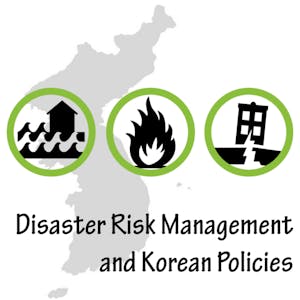In the Disaster Risk Management and Korean Policies course, explore the invaluable lessons learned from Korea's experience in building disaster resilience without unnecessary sacrifices. Gain a comprehensive understanding of disaster risk management and the historical path of major disasters, as well as the utilization of science and technology to find solutions to complex tasks. The course also delves into sound practices and institutional reforms of Korea, offering a roadmap to prevent and mitigate the catastrophic effects of disasters.
Through this course, gain insights into disaster risk management and the necessary steps for a disaster-resilient future, encompassing prevention, mitigation, preparedness, response, and relief. Upon completion, you will be equipped to explain and implement effective disaster risk management strategies.
Certificate Available ✔
Get Started / More Info
The course includes modules on conceptual frameworks for disaster risk management, the evolution and theories of disasters in Korea, sound disaster risk management policies, the role of science and technology in disaster risk management, and recommendations for building a disaster-resilient nation.
Gain insights into the conceptual framework for disaster risk management, understanding the concept of disaster and exploring effective strategies for disaster resilience. This module provides a foundational understanding of disaster risk management.
Delve into the evolution and theories of disasters in Korea, including the major disasters and subsequent response evolution. Understand power-law distribution and its implications in disaster risk management, providing valuable insights into disaster scenarios.
Explore the sound disaster risk management policies of Korea, focusing on prevention, mitigation, preparedness, response, and relief. Gain valuable knowledge on effective policies and strategies for building disaster resilience.
Analyze the role of science and technology in disaster risk management, including the use of geospatial information, on-site disaster information acquisition, and statistical data analysis. Understand how science and technology contribute to mitigating disaster effects.
Receive recommendations for building a disaster-resilient nation, emphasizing the enhancement of comprehensiveness, professionalism, risk analysis, governance, situational awareness, resilience, sustainability, and inclusiveness. Gain actionable insights for implementing disaster-resilient policies and practices.
Embark on a journey to understand nature like a biologist, exploring the interdependence of life, the science of evolution, and the incredible diversity of living...
This course explores the resource estimation, intermittency, and forecasting of hydro, wind, and solar power. It provides insights into the physical causes of variability...
Planning for Climate Change in African Cities provides a comprehensive understanding of urban resilience and adaptation to climate change in African cities, offering...
Wasser in der Schweiz is an in-depth exploration of the significance of water in Switzerland, covering its sources, hydrological concepts, water quality, and societal...